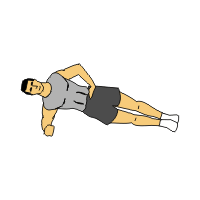The old days of props being short and fat are long gone. The modern game requires them to have good ball handling skills and be mobile, as well as great strength to withstand the physical hardships of being a forward. England's Andrew Sheridan (6'3 and 19st) is a prime example of the modern prop.
 |
| England's Andrew Sheridan |
Studies have found as much as 7928N of forward force can be generated through the front row of an International scrum at the point of engagement; that's 813kg of pressure! Preparing your body for these forces is not only vital for your personal success, but also in the prevention of injury. Players involved in the scrum, particularly the front row (Props and Hooker) need to have a strong neck and shoulders along with great core strength. Propping is a highly specialised position and although rare, catastrophic injury can occur with a heightened risk when a scrum collapses. In order to minimise this risk, rules state that a player cannot engage with their shoulders lower than their hips. Scrum coaches suggest a player should take a low body position, with a straight back and a knee angle of 115-125 degrees.

Front Plank
Lie prone (face down) on the floor. Place your forearms on the ground, elbows under your shoulders. Inhale and slowly raise your torso up, keeping weight on the forearms and balls of your feet. Exhale at the top and hold, continuing to breath relaxed and controlled throughout. Don't allow your hips to rise or drop. Imagine trying to balance a glass of water on your lower back without spilling it. Hold for: Beginner - 10secs, Intermediate - 20secs, Advanced - 30secs +.
Progressions
- Raise one foot off the ground by flexing at the knee.
- Perform on stability ball.

Side Plank
Lie on your side and support your bodyweight with your elbow (directly under your shoulder), hip and ankle. Inhale and slowly raise your torso so that the weight is now firmly on your elbow and foot. Exhale at the top and maintain relaxed and controlled breathing. Keep the other hand on your hip. Maintain a straight line from head to toe; don't allow your hips to deviate. Hold for: Beginner - 10secs, Intermediate - 20secs, Advanced - 30secs +.
Progression
- Perform in front of a cable machine. Use non weight bearing arm to row cable towards you whilst maintaining perfect form and posture.
Bird Dog
Get on all fours, knees and feet shoulder width apart whilst positioning your hands directly under your shoulders, fingers facing forward. Whilst keeping the spine in a neutral position, squeeze your abs, then flex one shoulder joint and extend the opposite hip. The arm should straighten and move forward, your opposite leg should straighten and move backward. When both are parallel to the ground hold position keeping both shoulders parallel to the ground. Slowly lower back down to start position. Hold for: Beginner - 5secs, Intermediate - 15secs, Advanced - 25secs +.
Progression:
- When in the top position, draw 4 squares with each raised limb.
Hope these simple exercises you can do at home help. They are also beneficial to anyone looking at improving their core strength. I'll blog about neck strengthening later in the month, so keep an eye out for that.
I'm going to finish off with a short video clip of New Zealand All Blacks' Scrum coach, Mike Cron, doing a wonderful warm-up/core drill during an All Blacks scrum session.
Happy Training.
Sam B












